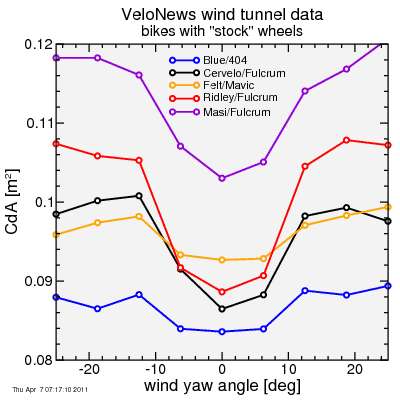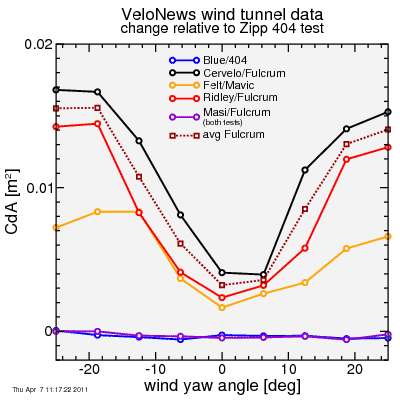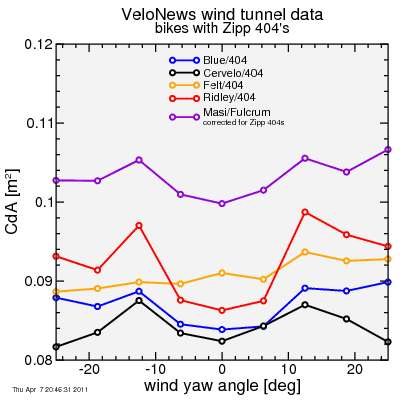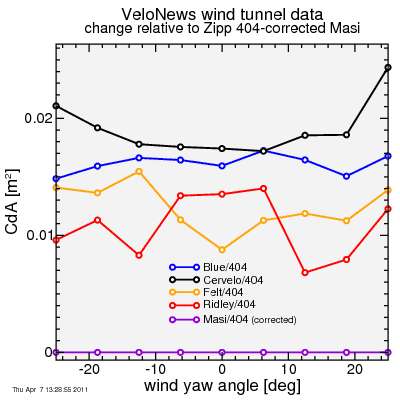VeloNews aero bike test: playing with the numbers
I've been spending a lot of train time playing around with puzzles, doing "work-work", and even reading the newspaper following recent world events. Time to get back to those VeloNews frame data.
VeloNews plots its drag force in grams. Grams is not a standard unit of force. A "gram" of force is defined as the force exerted by a standard gravity on a one-gram mass. But with wind resistance, we're probably most interested in power. And to get watts from force we want the standard metric unit of force, which is Newtons. Newtons multiplied by meters/second equals watts. So I converted their data to Newtons.
But even then, Newtons are good only for the relative wind speed at which they did the test. Actual force depends on relative wind speed and air density. Wind resistance force is generally proportional to the product of air density and the square of the relative wind speed. I don't know the air density, but I can guess it was close to 1.2 kg/m³, since they tested close to sea level (in North Carolina) as opposed to, for example, a wind tunnel in Boulder CO, which is where the VeloNews offices are. Air density falls approximately 1% each 100 meters gained in altitude, at a given air temperature. So being in Boulder at 1600 meter altitude would make a big difference.
Furthermore, I of course assumed wind force is proportional to the square of wind speed. This is often quoted as an exact result, but it is not: it is based on simplifying assumptions. But it works quite well. In any case, if CdA is considered a weak function of speed, then the CdA's I derive here are assumed to apply best at near 30 mph.
So here's VeloNews' data, where each bike was tested in a "stock" configuration:

I don't place much value in these data alone: the wheels are a huge component in the result, and it's a lot easier to swap wheels than it is to swap frames. But VeloNews did a good thing on these tests: they also tested the frames with Zipp 404 Firecrest wheels, which are probably the best non-HED clincher wheels sold from an aerodynamic perspective for their rim depth. The exception was the Masi "control" bike (the Masi not designed for aerodynamics), which was tested with Fulcrum wheels both times. I can try to fix that error, however.
Anyway, here's the comparison of the two tests, the increased resistance of the stock wheels versus the Zipp 404's:

The Zipps are not so surprisingly far superior to the Fulcrums, especially at large yaw, but perhaps more surprising is the substantial advantage at large yaw of the Zipps over the Mavic Cosmics.
Note two bikes offered the Fulcrum vs. Zipp comparison: the Cervelo and the Ridley. The two were improved by the Fulcrum-Zipp swap remarkably similarly: the Cervelo benefited a bit more at every measured yaw, but the two improvement curves track closely together. For a lack of anything better I took the average of the two results (shown in the plot) to apply to the Masi to predict how the Masi would have performed with Zipp 404's, since all other bikes were tested with 404's in addition to their stock wheels. I plot that result versus the actual results from VeloNews for the other bikes with the Zipps:

If you compare this to the plot from the article, in the article the advantage of the aero frames versus the Masi at high yaw was profound. Here you see the high-yaw boost is mostly from the wheels. The curves here track fairly parallel.
The Felt is rather striking in its relatively poor low-yaw result. This seems to contradict the Tour magazine result where the Felt AR did quite well at low yaw. In the VeloNews it is conjectured the thick bar tape on that bike is in part responsible. Wider handlebars would also contribute to poor low-yaw drag.
I take the difference in yaw between the Masi and each bike, using the Zipp-corrected Masi numbers. Each 0.01 m² difference in CdA translates to an approximate 1% difference in speed at a given power for wind-resistance-limited riding (recall Tour magazine measured approximately 0.32 m² total for a dummy rider + bike, and it takes a 3% change in power to change speed 1% in the wind-resistance limit).

These are nice results from VeloNews, although perhaps slightly overstated due to the lack of a rider and any water bottle on the bike, and the differences in handlebars, tape, saddles, and cables make it difficult to put too much importance on small differences between bikes. But I hope VeloNews continues with their testing: it'e great to get numbers to play with.
VeloNews plots its drag force in grams. Grams is not a standard unit of force. A "gram" of force is defined as the force exerted by a standard gravity on a one-gram mass. But with wind resistance, we're probably most interested in power. And to get watts from force we want the standard metric unit of force, which is Newtons. Newtons multiplied by meters/second equals watts. So I converted their data to Newtons.
But even then, Newtons are good only for the relative wind speed at which they did the test. Actual force depends on relative wind speed and air density. Wind resistance force is generally proportional to the product of air density and the square of the relative wind speed. I don't know the air density, but I can guess it was close to 1.2 kg/m³, since they tested close to sea level (in North Carolina) as opposed to, for example, a wind tunnel in Boulder CO, which is where the VeloNews offices are. Air density falls approximately 1% each 100 meters gained in altitude, at a given air temperature. So being in Boulder at 1600 meter altitude would make a big difference.
Furthermore, I of course assumed wind force is proportional to the square of wind speed. This is often quoted as an exact result, but it is not: it is based on simplifying assumptions. But it works quite well. In any case, if CdA is considered a weak function of speed, then the CdA's I derive here are assumed to apply best at near 30 mph.
So here's VeloNews' data, where each bike was tested in a "stock" configuration:

I don't place much value in these data alone: the wheels are a huge component in the result, and it's a lot easier to swap wheels than it is to swap frames. But VeloNews did a good thing on these tests: they also tested the frames with Zipp 404 Firecrest wheels, which are probably the best non-HED clincher wheels sold from an aerodynamic perspective for their rim depth. The exception was the Masi "control" bike (the Masi not designed for aerodynamics), which was tested with Fulcrum wheels both times. I can try to fix that error, however.
Anyway, here's the comparison of the two tests, the increased resistance of the stock wheels versus the Zipp 404's:

The Zipps are not so surprisingly far superior to the Fulcrums, especially at large yaw, but perhaps more surprising is the substantial advantage at large yaw of the Zipps over the Mavic Cosmics.
Note two bikes offered the Fulcrum vs. Zipp comparison: the Cervelo and the Ridley. The two were improved by the Fulcrum-Zipp swap remarkably similarly: the Cervelo benefited a bit more at every measured yaw, but the two improvement curves track closely together. For a lack of anything better I took the average of the two results (shown in the plot) to apply to the Masi to predict how the Masi would have performed with Zipp 404's, since all other bikes were tested with 404's in addition to their stock wheels. I plot that result versus the actual results from VeloNews for the other bikes with the Zipps:

If you compare this to the plot from the article, in the article the advantage of the aero frames versus the Masi at high yaw was profound. Here you see the high-yaw boost is mostly from the wheels. The curves here track fairly parallel.
The Felt is rather striking in its relatively poor low-yaw result. This seems to contradict the Tour magazine result where the Felt AR did quite well at low yaw. In the VeloNews it is conjectured the thick bar tape on that bike is in part responsible. Wider handlebars would also contribute to poor low-yaw drag.
I take the difference in yaw between the Masi and each bike, using the Zipp-corrected Masi numbers. Each 0.01 m² difference in CdA translates to an approximate 1% difference in speed at a given power for wind-resistance-limited riding (recall Tour magazine measured approximately 0.32 m² total for a dummy rider + bike, and it takes a 3% change in power to change speed 1% in the wind-resistance limit).

These are nice results from VeloNews, although perhaps slightly overstated due to the lack of a rider and any water bottle on the bike, and the differences in handlebars, tape, saddles, and cables make it difficult to put too much importance on small differences between bikes. But I hope VeloNews continues with their testing: it'e great to get numbers to play with.

Comments